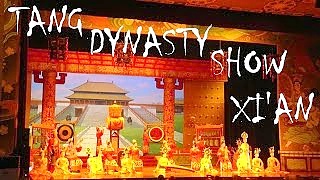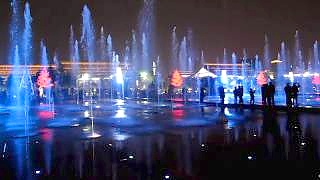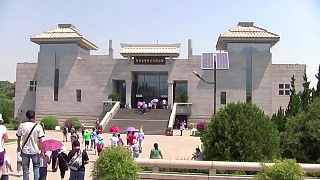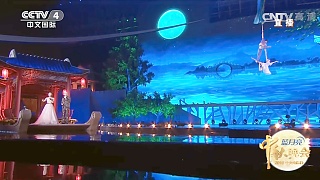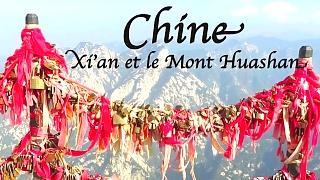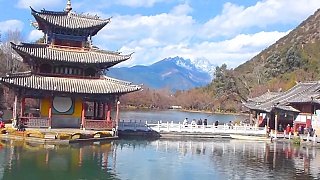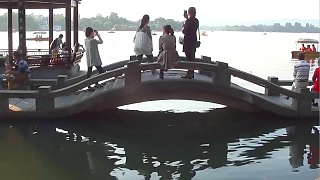Xi'An: 20 Kid-Friendly Places to Visit
- Huaqing Palace (华清池 Huáqīng Chí): Historic site with hot springs, gardens, and pavilions.
- Xi'an City Wall (西安城墙 Xī'ān Chéngqiáng): Ancient fortification with walkable ramparts and city views.
- Shaanxi History Museum (陕西历史博物馆 Shǎnxī Lìshǐ Bówùguǎn): Exhibits on Shaanxi's history, culture, and artifacts.
- Xi'an Forest of Stone Steles Museum (西安碑林博物馆 Xī'ān Bēilín Bówùguǎn): Stone tablets with inscriptions, calligraphy, and art.
- Giant Wild Goose Pagoda (大雁塔 Dàyàn Tǎ): Buddhist pagoda with cultural relics, artifacts, and a fountain show.
- Tang Paradise (大唐芙蓉园 Dàtáng Fúróngyuán): Cultural theme park with Tang dynasty architecture, performances, and gardens.
- Xi'an Bell Tower (西安钟楼 Xī'ān Zhōnglóu): Historic tower with a bell, drum performances, and city views.
- Xi'an Drum Tower (西安鼓楼 Xī'ān Gǔlóu): Ancient tower with drum performances and city views.
- Qujiang Ocean World (曲江海洋世界 Qūjiāng Hǎiyáng Shìjiè): Aquarium with marine life exhibits, shows, and interactive experiences.
- Xi'an Qinling Wildlife Park (西安秦岭野生动物园 Xī'ān Qínlǐng Yěshēng Dòngwùyuán): Safari park with animals like pandas, tigers, and elephants.
- Da Ci'en Temple (大慈恩寺 Dàcí'ēn Sì): Buddhist temple with a giant Buddha statue and garden.
- Tang West Market Museum (大唐西市博物馆 Dàtáng Xīshì Bówùguǎn): Museum with exhibits on the Tang dynasty's market culture.
- Xi'an Botanical Garden (西安植物园 Xī'ān Zhíwùyuán): Botanical garden with diverse plant species and scenic landscapes.
- Shaanxi Children's Library (陕西省儿童图书馆 Shǎnxī Shěng Értóng Túshūguǎn): Library with children's books, activities, and events.
- Xi'an International Horticultural Expo Park (西安国际园林博览园 Xī'ān Guójì Yuánlín Bólǎn Yuán): Park with gardens, exhibitions, and cultural events.
- Yongxing Fang Food Street (永兴坊美食街 Yǒngxīng Fāng Měishí Jiē): Street food market with local snacks and specialties.
- Xi'an Silk Road Museum (西安丝绸之路博物馆 Xī'ān Sīchóu Zhīlù Bówùguǎn): Museum with exhibits on the Silk Road's history and artifacts.
- Xi'an Daming Palace National Heritage Park (西安大明宫国家遗址公园 Xī'ān Dàmíng Gōng Guójiā Yízhǐ Gōngyuán): Park with ruins of the Tang dynasty palace and gardens.
- Shaanxi Library (陕西省图书馆 Shǎnxī Shěng Túshūguǎn): Library with a vast collection of books, periodicals, and archives.
- Xi'an Museum (西安博物院 Xī'ān Bówùyuàn): Museum with exhibits on Xi'an's history, culture, and archaeology.
Xi'An: 30 More Places to Visit
- Xi'an Grand Mosque (西安大清真寺 Xī'ān Dà Qīngzhēnsì): Ancient mosque with Islamic architecture and a tranquil courtyard.
- Xi'an Great Mosque (西安大清真寺 Xī'ān Dà Qīngzhēnsì): Historic mosque with traditional Chinese and Islamic architecture.
- Xi'an Yongning Gate (西安永宁门 Xī'ān Yǒngníng Mén): Ancient city gate with towers, arches, and historic significance.
- Drum Tower Square (西安鼓楼广场 Xī'ān Gǔlóu Guǎngchǎng): Plaza with a water fountain, sculptures, and cultural events.
- Xi'an Stele Forest (西安碑林 Xī'ān Bēilín): Collection of stone tablets with inscriptions, calligraphy, and historical texts.
- Xi'an Famen Temple (西安法门寺 Xī'ān Fǎmén Sì): Buddhist temple with relics, pagodas, and ancient architecture.
- Xi'an Huashan Mountain (西安华山 Xī'ān Huàshān): Scenic mountain with hiking trails, temples, and stunning views.
- Big Wild Goose Pagoda North Square (大雁塔北广场 Dàyàn Tǎ Běi Guǎngchǎng): Square with sculptures, fountains, and cultural events.
- Gao Grand Courtyard (高家大院 Gāojiā Dàyuàn): Historic mansion with traditional architecture, courtyards, and gardens.
- Xingqing Palace Park (兴庆宫公园 Xīngqìng Gōng Gōngyuán): Park with historic ruins, gardens, and cultural exhibitions.
- Xi'an Silk Road International Museum (西安丝绸之路国际博物馆 Xī'ān Sīchóu Zhīlù Guójì Bówùguǎn): Museum with exhibits on the Silk Road's history, culture, and trade.
- Xi'an Small Wild Goose Pagoda (小雁塔 Xiǎo Yàn Tǎ): Buddhist pagoda with historic relics, artifacts, and gardens.
- Shaanxi Provincial Museum of Fine Arts (陕西美术馆 Shǎnxī Měishùguǎn): Museum with Chinese paintings, sculptures, and contemporary art.
- Shaanxi History Museum (陕西历史博物馆 Shǎnxī Lìshǐ Bówùguǎn): Exhibits on Shaanxi's history, culture, and artifacts.
- Xi'an Tang Art Museum (西安唐艺术博物馆 Xī'ān Táng Yìshù Bówùguǎn): Museum with exhibits on Tang dynasty art, ceramics, and sculpture.
- Xi'an Beilin Museum (西安碑林博物馆 Xī'ān Bēilín Bówùguǎn): Museum with stone tablets, calligraphy, and ancient inscriptions.
- Xi'an Mosque Food Street (西安回民街美食街 Xī'ān Huímín Jiē Měishí Jiē): Street food market with halal cuisine and local specialties.
- Xi'an Qujiang Polar Ocean Park (西安曲江北极洋公园 Xī'ān Qūjiāng Běijí Yáng Gōngyuán): Polar ocean park with marine life exhibits, shows, and activities.
- Xi'an Xingjiao Temple (西安兴教寺 Xī'ān Xīngjiào Sì): Buddhist temple with historic relics, statues, and prayer halls.
- Xi'an Confucius Temple (西安文庙 Xī'ān Wénmiào): Confucian temple with traditional architecture, gardens, and cultural events.
- Xi'an Islamic Food Street (西安回民街 Xī'ān Huímín Jiē): Street food market with halal cuisine, snacks, and traditional dishes.
- Xi'an Daming Palace National Heritage Park (西安大明宫国家遗址公园 Xī'ān Dàmíng Gōng Guójiā Yízhǐ Gōngyuán): Park with ruins of the Tang dynasty palace and gardens.
- Xi'an Sanyuan Palace (西安三原宫 Xī'ān Sānyuán Gōng): Taoist temple with historic architecture, statues, and gardens.
- Xi'an Shuyuanmen Ancient Cultural Street (西安书院门古文化街 Xī'ān Shūyuàn Mén Gǔ Wénhuà Jiē): Historic street with traditional architecture, shops, and cultural activities.
- Xi'an Huayan Temple (西安华严寺 Xī'ān Huáyán Sì): Buddhist temple with ancient architecture, sculptures, and gardens.
- Xi'an Tang Paradise (西安大唐芙蓉园 Xī'ān Dàtáng Fúróngyuán): Cultural theme park with Tang dynasty architecture, performances, and gardens.
- Xi'an Qianling Mausoleum (西安乾陵 Xī'ān Qiánlíng): Imperial tomb site with historic artifacts, sculptures, and mausoleums.
- Xi'an Great Mosque (西安大清真寺 Xī'ān Dà Qīngzhēnsì): Historic mosque with traditional Chinese and Islamic architecture.
- Xi'an Bell Tower (西安钟楼 Xī'ān Zhōnglóu): Historic tower with a bell, drum performances, and city views.
- Xi'an Museum of Modern Art (西安当代美术馆 Xī'ān Dāngdài Měishùguǎn): Museum with contemporary art exhibitions and installations.
Xi'an, located in the heart of Shaanxi Province in northwest China, is one of the oldest cities in China and served as the capital for numerous dynasties, including the Qin, Han, and Tang. Renowned for its rich history, cultural heritage, and iconic landmarks, Xi'an is a must-visit destination for tourists. Here's a guide for tourists visiting Xi'an:
Historical and Cultural Significance:
Ancient Capital: Xi'an served as the capital of China for over 13 dynasties and played a crucial role in shaping Chinese history and civilization. It was the starting point of the ancient Silk Road, facilitating trade and cultural exchange between China and the West.
Terracotta Army: One of Xi'an's most famous attractions is the Terracotta Army, a vast collection of life-sized terracotta sculptures depicting the armies of Qin Shi Huang, the first Emperor of China. Discovered in 1974, the Terracotta Army is a UNESCO World Heritage site and a symbol of China's rich cultural heritage.
Top Attractions:
Terracotta Army Museum: Located about 30 kilometers east of Xi'an, the Terracotta Army Museum is home to thousands of intricately crafted terracotta warriors, horses, and chariots. Visitors can explore the excavation pits, marvel at the craftsmanship, and learn about the history of the Qin Dynasty.
Ancient City Wall: Xi'an is renowned for its well-preserved ancient city wall, which dates back to the Ming Dynasty. Stretching over 13 kilometers in length, the wall offers panoramic views of the city and is a popular spot for walking, cycling, and sightseeing.
Muslim Quarter: Explore the vibrant Muslim Quarter, located near the Drum Tower and Great Mosque of Xi'an. This bustling neighborhood is known for its lively street markets, traditional Islamic architecture, and delicious street food, including lamb skewers, roujiamo (Chinese hamburger), and hand-pulled noodles.
Big Wild Goose Pagoda: Built during the Tang Dynasty, the Big Wild Goose Pagoda is a prominent Buddhist landmark in Xi'an. Visitors can climb the pagoda for panoramic views of the city or explore the surrounding temple complex and gardens.
Shaanxi History Museum: Discover the rich history and culture of Shaanxi Province at the Shaanxi History Museum. The museum houses a vast collection of artifacts, including ancient pottery, bronze ware, jade, and Tang Dynasty murals, providing insights into the region's heritage.
Practical Tips:
Transportation: Getting around Xi'an is convenient with its extensive public transportation system, including buses, taxis, and the Xi'an Metro. Bicycle rentals are also available for exploring the city at a leisurely pace.
Weather: Xi'an has a continental climate with hot summers and cold winters. The best time to visit is during spring (April to May) and autumn (September to October) when the weather is pleasant and comfortable.
Language: Mandarin Chinese is the official language spoken in Xi'an, although English may not be widely spoken, especially in more remote areas. It's helpful to learn some basic phrases or carry a phrasebook or translation app.
Currency: The currency used in China is the Chinese Yuan (CNY). Credit cards are accepted at most hotels, restaurants, and shops in urban areas, but it's advisable to carry cash for small purchases and transactions.
Xi'an offers a fascinating blend of ancient history, cultural heritage, and modern urban life, making it an enchanting destination for tourists seeking to explore the wonders of ancient China. Whether marveling at the Terracotta Army, walking along the ancient city wall, or sampling delicious street food in the Muslim Quarter, Xi'an has something to offer for every traveler.
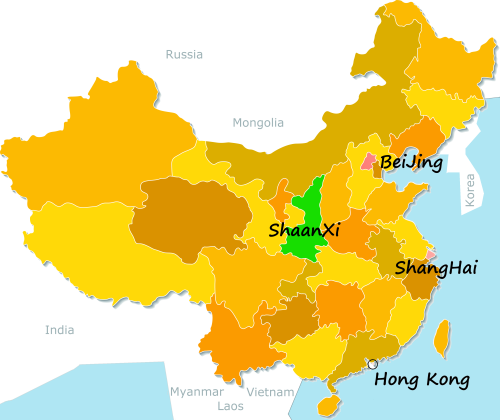
 50 places to visit in Xi’An
50 places to visit in Xi’An


